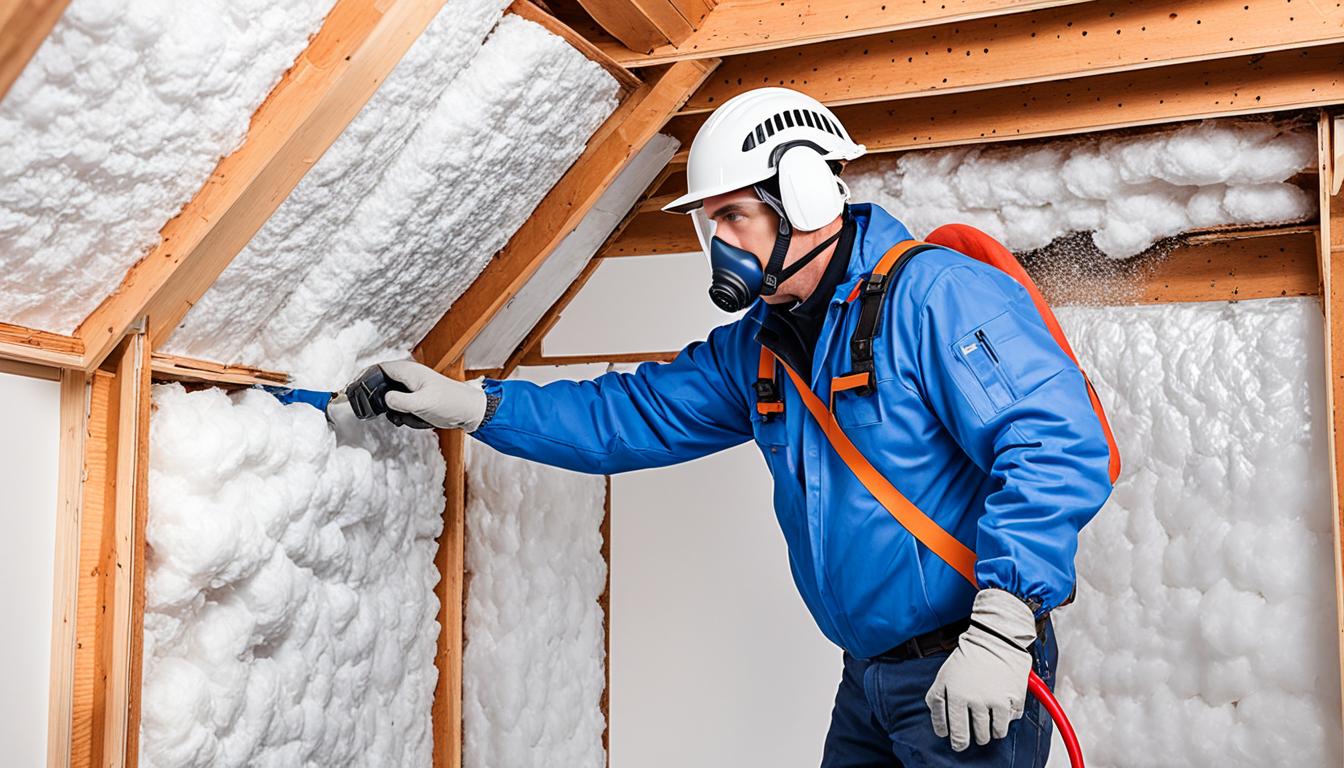Top DIY Spray Foam Insulation Tips & Tricks
Do you want to cut down your energy bills? Are you tired of your home's temperature always changing? DIY spray foam insulation is the answer. It saves on energy costs and makes your home more comfy and efficient.
VB Insulation lets you get pro-level insulation right at home. But, knowing the best tips and tricks first is key to success.
In this article, we'll explore DIY spray foam insulation. This includes guidance on techniques and how to apply it. Whether you've done a lot of DIY or you're just starting, you'll learn how to make your project better.
Key Takeaways:
- DIY spray foam insulation saves money and makes your home nicer.
- Doing it right is important for the best results.
- Insulating with spray foam lowers energy bills and improves comfort.
- VB Insulation has what you need for your DIY insulation.
- Read on for the best tips and tricks in DIY spray foam insulation!
Insulating Your Home with Spray Foam: Benefits and Techniques
If you're looking to make your home more energy efficient, spray foam insulation is a great choice. It helps reduce your energy bills. Beyond saving money, it also improves your home's insulation and air quality. We'll look deep into the benefits of spray foam and the best ways to apply it for top results.
The Benefits of Spray Foam Insulation
Compared to other insulation, spray foam has unique advantages. Here are its main benefits:
- It seals your home's gaps and cracks well, stopping air leaks and heat loss.
- It makes your home more energy efficient, keeping your indoor temperature steady. This can lower your heating and cooling needs.
- It improves comfort by eliminating drafts and ensuring even temperatures.
- It fights off moisture, preventing mold growth and water damage.
- Its dense structure is a good sound barrier, reducing noise from outside.
The next step is learning how to apply spray foam effectively.
Read More: Benefits of Spray Foam Insulation
Best Spray Foam Insulation Techniques
To get the most out of spray foam, you need to use the right techniques. Here are some tips to keep in mind:
- Make sure the area is clean, dry, and clear of dust before spraying.
- Wear protective gear like gloves and goggles to stay safe.
- Start with easy to reach spots to practice before moving on to harder areas.
- Apply the foam in layers to let each layer dry properly and avoid drooping.
- Keep a consistent distance from the application surface when spraying.
- Focus on sealing doors and windows well to reduce air leaks.
Following these techniques can help you get the most out of your spray foam insulation.

DIY Foam Insulation Step-by-Step Guide
Are you eager to start your DIY foam insulation project? Our guide will walk you through, making sure your effort is both successful and efficient. By following these tips and tricks, you'll use spray foam insulation like a pro and get your house well insulated.
Gather Your Materials
Before you start, check you have everything you need for the insulation job. You'll need a spray foam insulation kit, protective gear like clothing, gloves, and goggles, a caulk gun, a utility knife, and expanding foam cleaner.
Prepare the Work Area
Get your work area ready by making it clean and open. Also, don't forget to protect any nearby objects or surfaces from spray foam.
Read and Follow the Instructions
Reading the spray foam kit’s instructions is crucial. Make sure you understand how to apply the foam and stay safe while doing so.
Start with Small, Test Areas
Testing the foam on small areas first is smart. This lets you understand its expansion behavior. It grants you better control over how you apply it.
Apply the Foam Insulation
Hold your spray gun perpendicular to the area and apply in one go. Start at the top and move downwards. Be sure you fill every gap and crack thoroughly.
Smooth and Shape the Foam
You can tidy up the foam after applying it. Use a putty knife or a shaping tool to get the look just right. This step ensures your insulation looks neat.
Clean Up Excess Foam
Any foam you don't need should be removed with a utility knife or cleaner. Be gentle to avoid harm to the surrounding surfaces.
Allow Sufficient Curing Time
Let the foam cure and expand entirely. It takes a few hours but could be longer based on the product and the weather. Always check the product's instructions for curing details.
Inspect and Finish
After the foam has set, check if you missed any spots or if it looks uneven. Fix these issues if you find any. Then, take off all protection and clean your space.
Well done! You’ve finished your foam insulation project with success. Your home will now be more energy efficient and comfortable.
It’s clear that following our detailed guide makes the foam insulation project much smoother. These steps are designed to get you the best results and make your home's insulation top-notch.

Cost-Effective Insulation Tips for the Eco-Conscious Homeowner
Finding cost-effective insulation for your home, which is also eco-friendly, is key. It cuts energy costs and is good for the planet. Doing it yourself and choosing green materials leads to big savings and less CO2.
Read More: Spray Foam Insulation Cost Per Square Foot
1. Seal Air Leaks
Keep your home warm by fixing air leaks. These leaks make your AC/Heating work more, bringing up bills. Use weatherstripping, caulk, or foam to seal doors and windows.
2. Install Energy-Efficient Windows
Get new windows that keep your home's temp steady. Look for ones with low U-values and high R-values. They should be double or triple paned with special gas inside.
3. Use Recycled Insulation Materials
Try insulation made from recycled materials for a green choice. Things like denim, cellulose, or sheep wool work well. They keep you warm and are easy on the earth.
4. Insulate Your Attic
Don't forget your attic. It's where a lot of heat can escape. Use fiberglass, mineral wool, or spray foam to keep the heat in. This lowers energy use.
5. Use Reflective Foil Insulation
Reflective foil stops heat from getting in your home. Use it in the attic, on the roof, or under the floor. It keeps indoors cooler.
6. Consider DIY Spray Foam Insulation Kits
DIY spray foam kits are great for sealing gaps. They're affordable and make your home more energy-efficient. Just be careful and follow the instructions closely.
7. Conduct an Energy Audit
Start with an energy audit to see where you need insulation. Pros can tell you what's best for your home. It saves energy and money.
8. Utilize Natural Insulation Alternatives
Look into natural materials like straw, cork, or hemp. They insulate well and are good for the planet. These are renewable and eco-friendly.
9. Maximize Insulation in Crawlspace and Basement
Insulate your crawlspace and basement too. It's important for overall energy use. Use foam insulation to keep heat in and moisture out.
These tips will help you make a cozy, energy-efficient home. You'll save money and help the environment. It’s a win-win for your wallet and the planet.
Achieving Energy Efficiency with Spray Foam Insulation
Spray foam insulation can change how your home uses energy. It not only keeps your house warm in winter and cool in summer. It also helps save a lot of money on your energy bills. Plus, it makes your home more pleasant and better for the environment.
The Advantages of Spray Foam Insulation
Spray foam works by sealing all the tiny holes and cracks in the walls. This means air can't leak in or out easily. It keeps the air inside at the right temperature, meaning you use less energy to heat or cool your house. This saves you money and helps the environment too.
- Enhanced thermal performance: It's more effective than regular insulation at keeping your home's temperature steady. This means your home stays cozy during winter and cool in summer.
- Airtight seal: The foam can cover and seal even the tiniest spots. This stops cold drafts and keeps the temperature even throughout your home.
- No moisture intrusion: It acts as a shield against dampness, which can cause mold. This makes your home healthier and safer.
- Noise reduction: It's also great at keeping outside noises from coming in. That way, your home is a quieter and more peaceful place to be.
It’s clear why many homeowners choose spray foam. It's not only good for saving energy. It also makes your home a better place to live.
Read More: DIY spray foam insulation metal building
Conclusion
VB Insulation's DIY spray foam insulation is both budget-friendly and good for our planet. Using these ideas and methods can significantly lower your energy costs. Plus, it helps us move towards a more green future.
By choosing VB Insulation, you can keep your home cozy all year. Their products (V600 Close cell kit, V200 Close cell kit) stop air from leaking out, which keeps your house warmer or cooler. This cuts down the need for large heating and cooling systems, saving you money over time.
Get started on your insulation project with VB Insulation's simple spray foam products. Save on energy, make your home nicer, and help the environment. Opt for VB Insulation to make your future brighter and more sustainable.
FAQ
Can I apply spray foam insulation myself?
Yes, you can apply spray foam insulation yourself. Follow the instructions carefully. This ensures you use it correctly and safely.
How much does spray foam insulation cost?
The price of spray foam insulation changes based on your project's size and the foam type. To get the best price, compare quotes from different sources.
Is spray foam insulation better than traditional insulation methods?
Indeed, spray foam insulation has clear advantages. It boosts energy efficiency, seals air better, and improves sound control.
Can I use spray foam insulation to insulate my walls?
Yes, it's great for walls. It fills every gap and crack, giving a strong seal. This leads to better insulation.
How long does spray foam insulation last?
Properly installed, spray foam insulation can last forever. It keeps its shape and performance, not degrading over time.
Is spray foam insulation eco-friendly?
Spray foam is good for the environment. It cuts down on energy use and emissions. It keeps pollutants and allergens outside, making your home healthier.
Can I save money on insulation with DIY techniques?
DIY spray foam can cut costs. Make sure you learn the right way to use it. Safety first for a good insulation job.
What are the benefits of using spray foam insulation?
It makes your home more energy-efficient. You'll be cozier and hear less noise. Spray foam can also keep moisture out and lower your bills.
Is spray foam insulation suitable for all types of homes?
It fits in almost any home, from new builds to historic houses. Spray foam works well in various structures, providing great insulation.
What safety precautions should I take when using spray foam insulation?
Always wear protective gear like gloves and goggles. Use a respirator too. And keep the area well-ventilated to avoid breathing harmful fumes.




